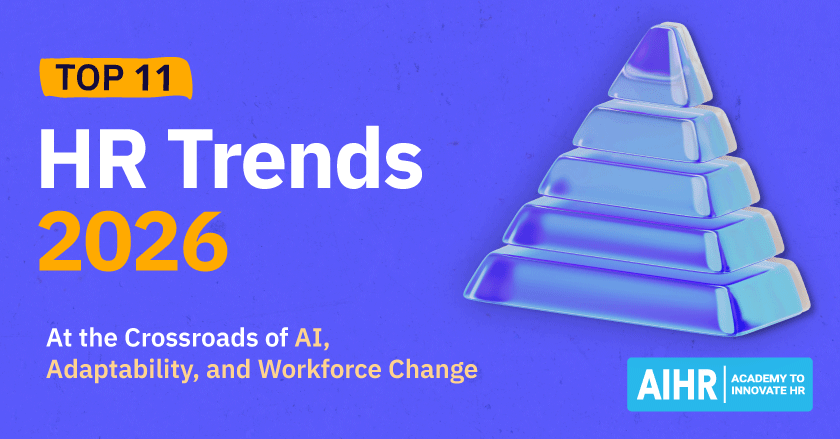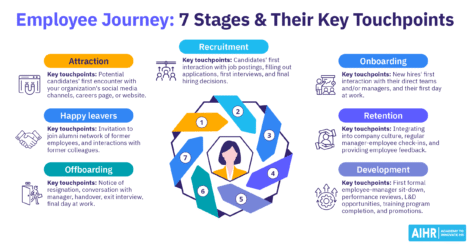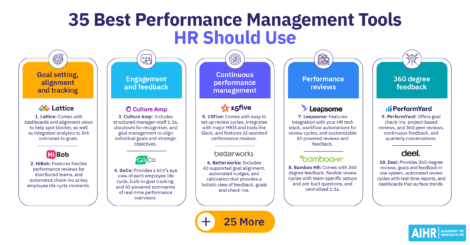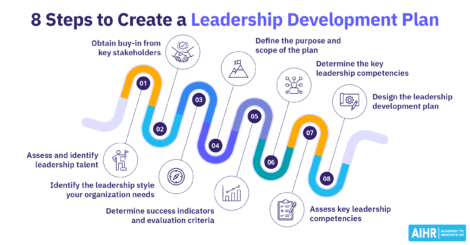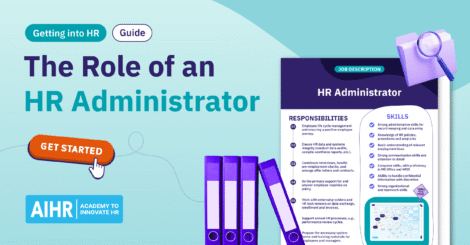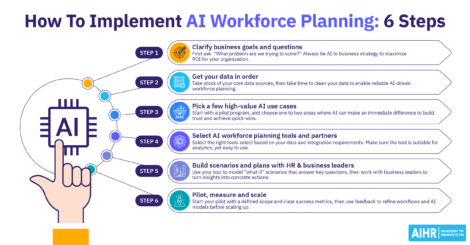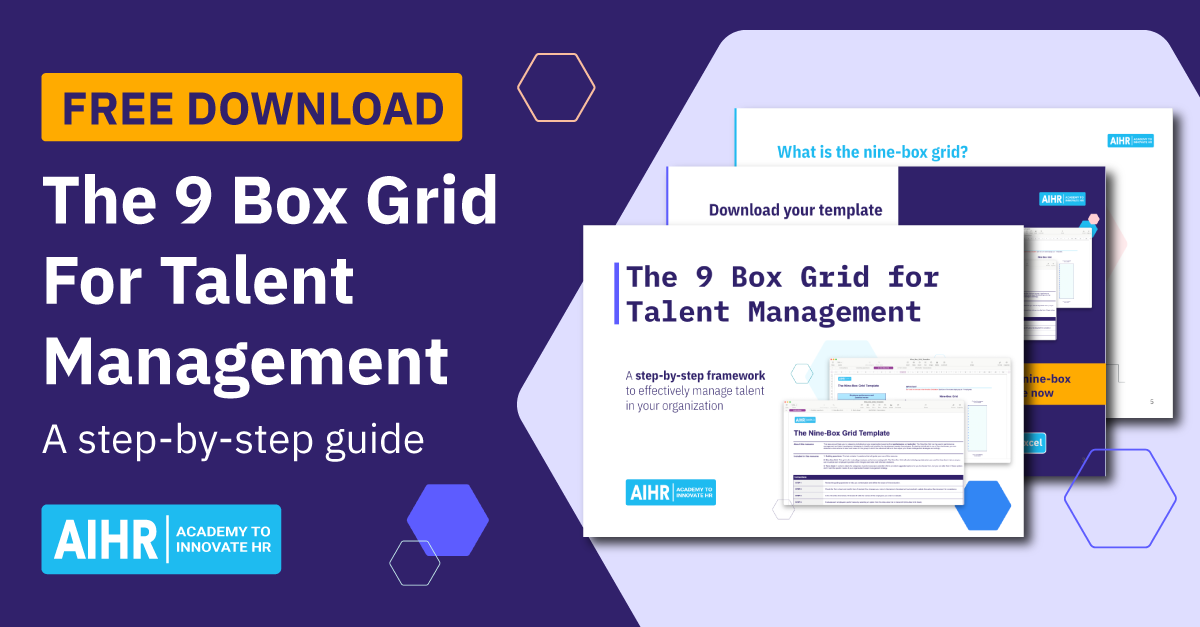The 9 box grid remains a popular talent management tool, but it may not always provide the full picture of employee performance and potential. The good news is there are several alternatives that HR teams can explore.
In a Gallup survey of CHROs, only 3% strongly agreed that their business is excellent at spotting and selecting the right candidates for management positions. In addition, while 64% of CHROs report their organizations use the 9 box grid tool for succession planning decisions, only 9% strongly agree that it’s effective.
Traditionally used to evaluate and compare performance and identify high-potential employees suitable for leadership development, the 9 box model places employees into one of nine classifications on a grid. And while the tool has its benefits, it also has several limitations, which we’ll explore in this article, so that you can choose the right approach for your organization.
Contents
Limitations of the 9 box grid
9 box grid alternatives comparison
Alternative 1: Simplified 4 box grid
Alternative 2: Skill Will Matrix
Alternative 3: Competency models
Alternative 4: Talent profiles
Alternative 5: AI-driven predictive models for talent management
How to choose your talent assessment framework
FAQ
Limitations of the 9 box grid
The 9 box grid works well in some contexts, but for many organizations, it’s too limited to capture the complexity of modern performance and development needs. Here’s why:
It takes the annual performance review approach
The 9 box grid method typically takes a once-a-year approach, where an employee receives a subjective rating by their manager. Many organizations are transitioning to methods based on continuous feedback that incorporate a variety of sources, offering a more holistic view.
Not enough measurements of real data
Measuring employee potential is complex. Without data on factors like learning agility, career aspirations, and leadership behaviors, the 9-box grid often depends heavily on subjective judgment, which can make its outcomes less reliable.
Employees can’t be categorized into one of nine labels
The 9 box grid categorizes employees into nine segments based on performance and potential; however, this structure can oversimplify how people contribute and grow. In reality, employees often display a mix of strengths and qualities that don’t fit neatly into predefined boxes.
Can increase bias
Categorizing employees into fixed boxes can reinforce bias, as initial ratings often shape how managers perceive future performance. Once an employee is placed in a category, it can be difficult for them to be seen differently, even if their skills or results improve.
Can discourage employees
Employees who are placed in the low potential and/or low performance boxes are likely to become disheartened and demotivated. That, in turn, can have a negative impact on productivity and team morale, and ultimately drive people away.
Negatively affects historically marginalized employees
A recent study analyzing potential data for nearly 30,000 employees found that women receive significantly lower “potential” ratings compared to men, despite receiving higher job performance ratings. Not only does this indicate that employees from historically marginalized groups are likely to be negatively impacted by this method, but it also has the potential to sabotage DEI efforts by holding underrepresented groups back from leadership positions.
It’s outdated
Organizations are looking for alternatives to the 9 box grid method because it’s outdated, having been first created back in 1970. Since then, the workplace has undergone significant changes. Technology, automation, hybrid work, and shifting career expectations have transformed the way people work, the roles they hold, and how performance and potential are assessed.
Boost your talent management skills
Traditional tools like the 9 box grid have their place, but today’s talent challenges call for more flexible, forward-looking approaches. If you want to grow, retain, and develop your people effectively, it’s time to upgrade your skill set.
AIHR Talent Management Certificate Program helps you:
✅ Use data to build effective talent strategies
✅ Future-proof your business with a robust succession planning process
✅ Align talent practices with evolving business goals and workforce needs
🎓 Learn the full range of skills to manage talent proactively and create real business impact.
9 box grid alternatives comparison
| Model | Main focus | How it works | Strengths | Limitations | Best suited for |
| 9 box grid | Performance and potential | Employees are rated on two dimensions – performance and potential – and placed in one of nine boxes. | Simple visual overview; useful for succession planning. | Relies heavily on subjective judgment; static snapshot; can reinforce labels and bias. | Succession planning and leadership identification. |
| 4 box grid | Simplified performance and potential | Condenses the 9-box into four segments for easier categorization and discussion. | Easier to use and understand; good for quick calibration. | Still oversimplifies capabilities; provides only a moment-in-time view. | Small or fast-moving organizations needing a simple tool. |
| Skill Will Matrix | Skill level and motivation | Plots employees based on their ability (“skill”) and drive (“will”) to perform. | Practical for coaching and development; helps tailor management approaches. | Focuses on current behavior, not long-term potential; can be subjective. | Manager-employee coaching and performance improvement. |
| Competency model | Skills, knowledge, and behaviors | Defines required competencies and measures employees against them. | Aligns hiring, training, and performance with business goals; adaptable during change. | Requires ongoing maintenance and regular review. | Workforce planning, learning strategy, and organizational alignment. |
| Talent profiles | Individual strengths and development | Summarizes each employee’s skills, achievements, and aspirations for HR and managers. | Promotes transparency and career development; supports data-driven succession decisions. | Needs regular updates and accurate input from employees and managers. | Career development, internal mobility, and succession planning. |
| AI-driven predictive models | Data-based performance and potential insights | Uses AI to analyze performance, engagement, and learning data to predict trends or risks. | Scalable, proactive, and data-driven; helps identify patterns early. | May inherit bias from data; requires human validation and ethical oversight. | Large organizations leveraging analytics for talent decisions. |
Let’s take a closer look at the top 9 alternatives to the box grid.
Alternative 1: Simplified 4 box grid
Some companies replace the 9 box grid matrix with a 4 box model that has the following segments:
- High performance / High potential: Employees who show excellent performance and a strong ability to grow
- High performance / Lower potential: Employees who perform consistently but might have reached their peak in their current role
- Lower performance / High potential: Employees who have the potential to thrive but aren’t meeting performance targets, suggesting they might be in the wrong role or not being challenged enough
- Lower performance / Lower potential: These employees struggle to perform and show little potential for growth
Aiming to simplify the 9 box grid tool, the 4 box grid can be a helpful starting point when assessing an employee’s potential for growth, and makes it easier to categorize employees. As every business has its own values, goals, and culture, it’s recommended that you customize the grid by aligning it with your values and specific benchmarks and use language that fits with your identity.
However, it still carries several of the same drawbacks as the 9 box model. Because employees are categorized into fixed boxes, it risks oversimplifying their capabilities and reinforcing labels that may not reflect their full potential. And since reviews are typically conducted once a year, the 4 box grid model provides only a snapshot rather than a dynamic, ongoing view of employee performance and development.
Alternative 2: Skill Will Matrix
The Skill Will Matrix measures the skill and will of employees, and, similar to the 4 box grid, it places employees into one of four quadrants:
- Quadrant 1 – High skill / High will: This employee has the skill and will to succeed at work and should be delegated to.
- Quadrant 2 – Low skill / High will: This employee lacks some of the necessary skills to perform effectively, but they are motivated to improve and should be guided through training opportunities to develop their skills.
- Quadrant 3 – Low skill / Low will: This employee lacks both the skills to perform effectively and the determination to improve, and should be directed with clear tasks and closely supervised.
- Quadrant 4 – High skill / Low will: This employee has all the skills to perform and succeed at work, but lacks the motivation to do so, and needs to be excited by interesting tasks or recognition of achievements.
The Skill Will Matrix helps managers and HR teams to determine the talent management strategies needed to help all employees improve their performance and develop their careers within the organization. The result is a workforce of engaged and motivated individuals who are inspired to improve and strive to achieve their goals, ultimately helping the business reach its objectives.
Compared with the 9 box grid, the Skill Will Matrix focuses more on day-to-day behavior and motivation rather than long-term potential. It’s practical for coaching and development discussions, but can still be subjective, as managers’ perceptions of “will” or motivation often vary and can be influenced by bias or limited observation.
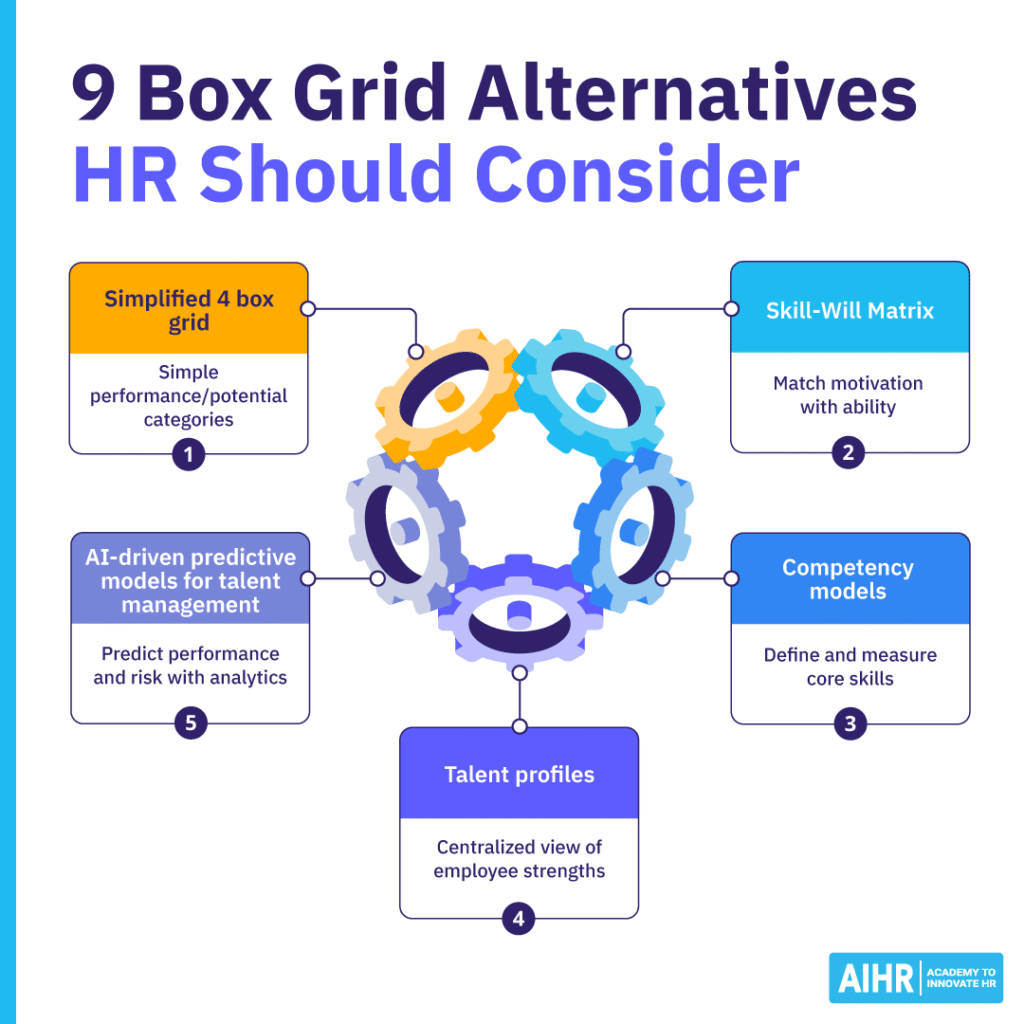
Alternative 3: Competency models
A competency model (for example, AIHR’s T-Shaped HR Competency Model) is a framework that outlines the skills, knowledge, and behaviors an employee must possess in order to perform their job effectively and succeed in a role. A competency model can help to shape the recruitment process, training and development initiatives, performance evaluations, succession planning, and leadership development. They’re also beneficial when organizations are experiencing significant change, such as during a restructuring or mergers and acquisitions, or when a business is struggling with performance issues.
You can evaluate employees against a competency model by assessing how their abilities align with and support the long-term business goals. Organizations can use this to track core competencies and critical skills and develop a skilled and aligned workforce.
Alternative 4: Talent profiles
A talent profile (sometimes called an employee or professional profile) is an internal summary of an employee’s education, skills, strengths, accomplishments, and job titles to date. Modern talent profiles often include verified skills based on performance reviews, peer feedback, and career development aspirations.
These profiles are typically accessible to the employee, their manager, and the HR department. They serve as a foundation for manager-employee development conversations and plans, and are often used to make key decisions on leadership development and succession planning.
Alternative 5: AI-driven predictive models for talent management
As the capability of generative AI grows, some organizations are leaning more on predictive analytics that highlight top-performing employees with the most potential for promotion, as well as those who are a flight risk, or have critical skill gaps.
For example, an AI system might analyze performance data, engagement scores, and learning activity to identify employees who are likely to excel in leadership roles or flag those showing early signs of disengagement and risk of leaving. While this can help HR act proactively, the insights still need to be reviewed by managers to account for context that data alone can’t capture.
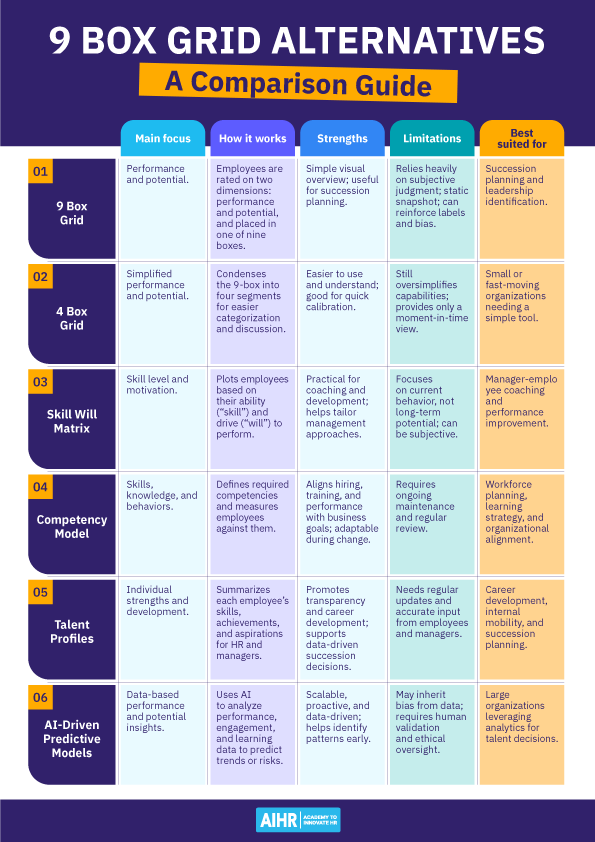
How to choose your talent assessment framework
- Clarify the purpose: Get clear on your goals and what you want to achieve, for example, do you need more leadership pipeline visibility, employee development planning, or a skills gap analysis? This depends on what is most important for your organization now and in the next few years. Perhaps it’s improving performance, identifying potential, upskilling or reskilling, or developing leaders.
- Assess data availability: Understand what data you already have (for example, performance review data, skills inventories, and engagement survey feedback) and what’s missing so that you know what you need to collect.
- Match framework to needs: Each of the tools above is helpful for different scenarios. Select the appropriate framework for your specific needs. For example, the 9 box grid can be helpful for succession planning, while talent profiles can be useful for ongoing skill development.
- Test on a small scale: Pilot your talent assessment framework with one team or function to see if it’s suitable and results in the right conversations and insights.
- Refine and roll out: Adjust your framework and approach based on feedback, then implement it across the wider business. Continue to monitor and refine it as the business’s needs evolve.
To sum up
There are many effective alternatives to the 9 box grid framework that can help you evaluate and compare performance, identify top talent, and develop a succession pipeline that fills your organization with talented future leaders. The key is to select an approach that aligns with your organization’s goals, culture, and stage of development. What works best will ultimately depend on your specific business needs and context.
FAQ
Many experts in the HR field argue that the 9 box grid tool is outdated, as it was originally conceived in 1970, when the world of work and business was vastly different. Yet, despite its age and limitations, it remains widely used thanks to its simplicity and familiarity in talent discussions.
The best alternative to the 9 box grid matrix depends on the needs of your organization, including your most pressing talent management issues and your long-term objectives.


